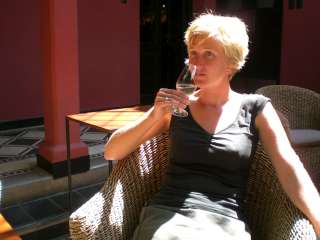 In my present state of mind*, I find it hard to imagine a better place in the world than Mendoza. They get 300 days of sun a year, the city is filled with huge, gorgeous trees, parillas (Argentine BBQ restaurants which universally serve gargantuan steaks) hover around almost every corner, and they are surrounded by wineries. Oh, and they’re within spitting distance of the Andes, not that I would ever spit wine.
In my present state of mind*, I find it hard to imagine a better place in the world than Mendoza. They get 300 days of sun a year, the city is filled with huge, gorgeous trees, parillas (Argentine BBQ restaurants which universally serve gargantuan steaks) hover around almost every corner, and they are surrounded by wineries. Oh, and they’re within spitting distance of the Andes, not that I would ever spit wine.
*We just returned to our hostel after having spent all day touring wineries; the last stop was for a 2-hour, 3-course lunch at a bodega’s French restaurant.
We knew we would like it here before we had even arrived because many people we had met had raved about the place. Of course, all they had to say was that the city is known as the Wine Capital of Argentina for us to visit. (Frankly, we would’ve flown to Argentina just for that.) So now we can confirm that, indeed, we do love it here. There are over 800 wineries in the near vicinity and the area is known as the Napa Valley of South America. Why is it that we had not visited sooner?
 Anyway, I could go on and on about the wine but will limit myself here to talking about one particular wine tasting facility: Vines of Mendoza. I don’t really know how to label this place; it’s sort of a wine club, tasting room, wine-tour arranger, enthusiasts’ meeting place, wine promoter type place. (They make money by exporting local wines to Europe and America.) But for us, it’s just a great, relaxed place to go to taste, and learn about wine.
Anyway, I could go on and on about the wine but will limit myself here to talking about one particular wine tasting facility: Vines of Mendoza. I don’t really know how to label this place; it’s sort of a wine club, tasting room, wine-tour arranger, enthusiasts’ meeting place, wine promoter type place. (They make money by exporting local wines to Europe and America.) But for us, it’s just a great, relaxed place to go to taste, and learn about wine.
Within two hours of our arrival in the city, we headed straight for the Vines based on a very high recommendation from fellow world travellers from Calgary. The atmosphere was not at all pretentious – as one kind of expects when speaking of a wine-reated facility – and we were completely comfortable as soon as we walked in. We got a brief tour and then were introduced to some of the services and tastings they had on offer. It didn’t take us long to decide that we would try the flight of Reserve wines immediately, followed by a Sensory Tasting the next day, and a reservation at the Wine & Cheese night the following day. We were like tipsy flies falling happily into their viney web.
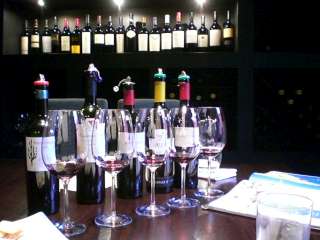 The hour and a half that followed was magnificent. We tasted five of Argentina’s Best wines, complete with an educated and friendly host who walked us through the regions, the varietals, the aging, the aromas and the tasting. (I’m edumacated in the wine, now.) After being so long in Asia without a drop of decent wine to be found, this was an absolutely exquisite way to spend the afternoon.
The hour and a half that followed was magnificent. We tasted five of Argentina’s Best wines, complete with an educated and friendly host who walked us through the regions, the varietals, the aging, the aromas and the tasting. (I’m edumacated in the wine, now.) After being so long in Asia without a drop of decent wine to be found, this was an absolutely exquisite way to spend the afternoon.
Really, I can’t say enough how much fun we had and how lovely the wine was, and this was only our first day! The bliss continues unabated.
P.S. If anyone cares to know which are the best reserve wines of Argentina… Angelica Zapata Malbec Alta 2003, O’Fournier Alfa Crux 2002, Bressia Profundo 2003, Carmelo Patti Gran Assemblage 2002, Yacochuya Malbec 2001.
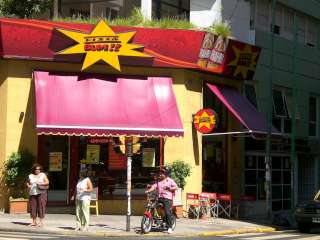
 The special tasting room (!!) was prepared with three different, non-blended local wines: a Torrontes, a Bonarda and a Malbec. However, in addition to the wines, there were tasting glasses filled with the flavours that one is meant to experience in each wine. For example, the glass of Bonarda was accompanied by a glass each of earth, dried leaves, quince jam, and pepper. So, after one swirls and takes notes on the wines appearance, one is meant to sniff the aroma and compare it to the raw elements. How much fun is THAT!
The special tasting room (!!) was prepared with three different, non-blended local wines: a Torrontes, a Bonarda and a Malbec. However, in addition to the wines, there were tasting glasses filled with the flavours that one is meant to experience in each wine. For example, the glass of Bonarda was accompanied by a glass each of earth, dried leaves, quince jam, and pepper. So, after one swirls and takes notes on the wines appearance, one is meant to sniff the aroma and compare it to the raw elements. How much fun is THAT! In my present state of mind*, I find it hard to imagine a better place in the world than Mendoza. They get 300 days of sun a year, the city is filled with huge, gorgeous trees, parillas (Argentine BBQ restaurants which universally serve gargantuan steaks) hover around almost every corner, and they are surrounded by wineries. Oh, and they’re within spitting distance of the Andes, not that I would ever spit wine.
In my present state of mind*, I find it hard to imagine a better place in the world than Mendoza. They get 300 days of sun a year, the city is filled with huge, gorgeous trees, parillas (Argentine BBQ restaurants which universally serve gargantuan steaks) hover around almost every corner, and they are surrounded by wineries. Oh, and they’re within spitting distance of the Andes, not that I would ever spit wine. Anyway, I could go on and on about the wine but will limit myself here to talking about one particular wine tasting facility: Vines of Mendoza. I don’t really know how to label this place; it’s sort of a wine club, tasting room, wine-tour arranger, enthusiasts’ meeting place, wine promoter type place. (They make money by exporting local wines to Europe and America.) But for us, it’s just a great, relaxed place to go to taste, and learn about wine.
Anyway, I could go on and on about the wine but will limit myself here to talking about one particular wine tasting facility: Vines of Mendoza. I don’t really know how to label this place; it’s sort of a wine club, tasting room, wine-tour arranger, enthusiasts’ meeting place, wine promoter type place. (They make money by exporting local wines to Europe and America.) But for us, it’s just a great, relaxed place to go to taste, and learn about wine. The hour and a half that followed was magnificent. We tasted five of Argentina’s Best wines, complete with an educated and friendly host who walked us through the regions, the varietals, the aging, the aromas and the tasting. (I’m edumacated in the wine, now.) After being so long in Asia without a drop of decent wine to be found, this was an absolutely exquisite way to spend the afternoon.
The hour and a half that followed was magnificent. We tasted five of Argentina’s Best wines, complete with an educated and friendly host who walked us through the regions, the varietals, the aging, the aromas and the tasting. (I’m edumacated in the wine, now.) After being so long in Asia without a drop of decent wine to be found, this was an absolutely exquisite way to spend the afternoon.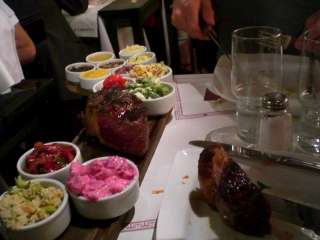 Two random couples we met raved about La Cabrera, a barbeque restaurant in Buenos Aries, one fellow saying he would return to BA just to go there. We showed up at 9pm, an early arrival by Argentinian standards, just to ensure we could get a seat without waiting, which we barely managed.
Two random couples we met raved about La Cabrera, a barbeque restaurant in Buenos Aries, one fellow saying he would return to BA just to go there. We showed up at 9pm, an early arrival by Argentinian standards, just to ensure we could get a seat without waiting, which we barely managed. We stopped first at a lookout over the ocean and the island owned and operated by the migratory cormorants. Guano was mined here for European fertilizer until about 1930 and judging by the smell, the birds have worked hard since then to replenish the supply. Fortunately, we had our trusty binoculars and so were able to see a fair bit of avian activity before setting up our cold breakfast in the picnic hut upwind of the island. After breakfast, we decided to take a crack at seeing los penguinos. I was not optimistic because it was so warm, I thought for sure they’d be on their way someplace cooler now and would have abandoned their colony. Plus, the hike through the desert to reach the colony did not inspire confidence for a viewing. This sign was so randomly placed as to seem a joke.
We stopped first at a lookout over the ocean and the island owned and operated by the migratory cormorants. Guano was mined here for European fertilizer until about 1930 and judging by the smell, the birds have worked hard since then to replenish the supply. Fortunately, we had our trusty binoculars and so were able to see a fair bit of avian activity before setting up our cold breakfast in the picnic hut upwind of the island. After breakfast, we decided to take a crack at seeing los penguinos. I was not optimistic because it was so warm, I thought for sure they’d be on their way someplace cooler now and would have abandoned their colony. Plus, the hike through the desert to reach the colony did not inspire confidence for a viewing. This sign was so randomly placed as to seem a joke.

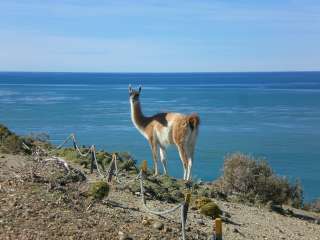

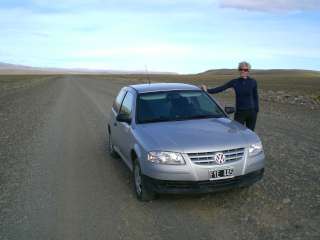 So, we rented a cute little Volkswagen, bought a map and a bunch of groceries and fired out onto the 297km gravel road that forms the majority of the connection between El Calafate and Puerto Santa Cruz. I don’t think I’ve ever been so much in the middle of nowhere as we were when we hit that gravel road.
So, we rented a cute little Volkswagen, bought a map and a bunch of groceries and fired out onto the 297km gravel road that forms the majority of the connection between El Calafate and Puerto Santa Cruz. I don’t think I’ve ever been so much in the middle of nowhere as we were when we hit that gravel road. 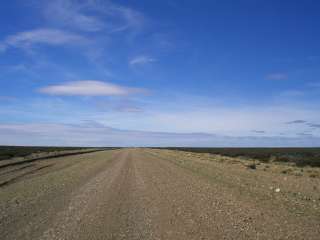
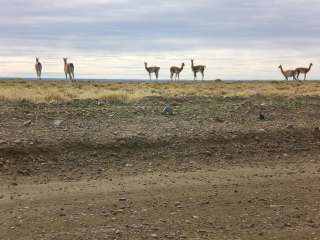 There were the usual suspects of rabbits and sheep, skunks and hawks, but there were also herds and herds of guanacos (sort of like llamas but less fuzzy) and a large bird whose name I don’t know but who looks and runs like an ostrich. Most fantastic of all, we saw a condor. I think we are exceptionally lucky to have spotted it on the side of the road right next to the huge river valley; it took off and floated on a thermal wind up and over and around our car for about 5 minutes. That bird is astonishingly large and to see it fly like that was amazing; this picture, nor my words, can hardly do it justice. We were agog.
There were the usual suspects of rabbits and sheep, skunks and hawks, but there were also herds and herds of guanacos (sort of like llamas but less fuzzy) and a large bird whose name I don’t know but who looks and runs like an ostrich. Most fantastic of all, we saw a condor. I think we are exceptionally lucky to have spotted it on the side of the road right next to the huge river valley; it took off and floated on a thermal wind up and over and around our car for about 5 minutes. That bird is astonishingly large and to see it fly like that was amazing; this picture, nor my words, can hardly do it justice. We were agog.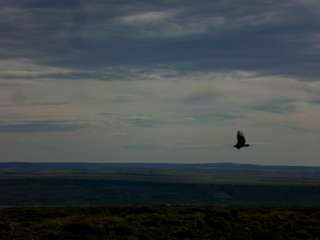
 At any rate, this allowed us to spend one full, sunny day at the stunning national park next door and also forced us to sleep in the car that night. It wasn’t nearly as bad as I thought it would be: a quiet campground, a great view, a couple bottles of wine with our picnic… who knew I’d ever be so happy to sleep in a Golf?
At any rate, this allowed us to spend one full, sunny day at the stunning national park next door and also forced us to sleep in the car that night. It wasn’t nearly as bad as I thought it would be: a quiet campground, a great view, a couple bottles of wine with our picnic… who knew I’d ever be so happy to sleep in a Golf?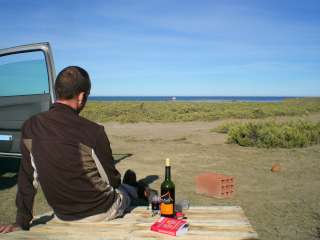
 n Argentina have everything ready for us. The starting point for us (and piles of other people) is El Calafate, a town of 18,000 people on the shore of a windy, glacial – and what must be terribly cold in the winter – Lake Argentino. On a clear day, with the Andes sparkling in the background, and the lake reflecting some perfect version of cloudy aquamarine, it reminds me of a blend of Banff and Lake Louise. I felt so at home here, and not just because of the steak nor the quaint stores and chocolate shops on Main Street nor the chilled air or fresh breeze, it was the people that reminded me of home. Half-tourist, half-outdoor folk, with a lot of hotels and restaurants to keep us all mingling.
n Argentina have everything ready for us. The starting point for us (and piles of other people) is El Calafate, a town of 18,000 people on the shore of a windy, glacial – and what must be terribly cold in the winter – Lake Argentino. On a clear day, with the Andes sparkling in the background, and the lake reflecting some perfect version of cloudy aquamarine, it reminds me of a blend of Banff and Lake Louise. I felt so at home here, and not just because of the steak nor the quaint stores and chocolate shops on Main Street nor the chilled air or fresh breeze, it was the people that reminded me of home. Half-tourist, half-outdoor folk, with a lot of hotels and restaurants to keep us all mingling.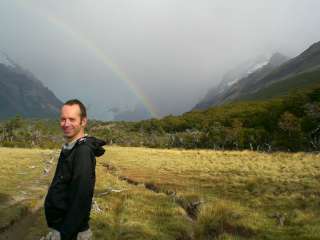 In the three days we were there, the sun shone for approximately five minutes, and the rest of the time it was either grey sky with gale force winds or rainy or both. Mostly both. However, with such a short time there, we couldn’t afford to wait for the weather and so we set out with a woman we met from Iowa and a fellow from Sydney to see Cerro de Torre. It turned out to be a lovely hike through forested area, which kept the wind and rain at bay, and we come upon some gorgeous views…
In the three days we were there, the sun shone for approximately five minutes, and the rest of the time it was either grey sky with gale force winds or rainy or both. Mostly both. However, with such a short time there, we couldn’t afford to wait for the weather and so we set out with a woman we met from Iowa and a fellow from Sydney to see Cerro de Torre. It turned out to be a lovely hike through forested area, which kept the wind and rain at bay, and we come upon some gorgeous views…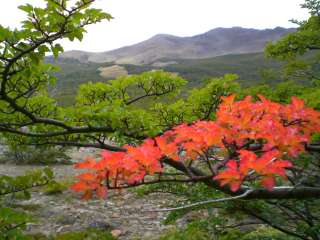
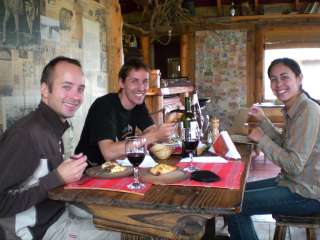
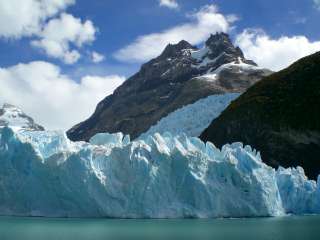 The orientation at our wonderful hostel boiled down to a few options: take the boat ride one day and hike on Perito Moreno glacier the next, unless you want to cheap out and just look at it, because that is what you do in El Calafate. There is only one tour company for the Glacier National Park and one ridiculously high price for each tour. We did as they instructed and signed up for both.
The orientation at our wonderful hostel boiled down to a few options: take the boat ride one day and hike on Perito Moreno glacier the next, unless you want to cheap out and just look at it, because that is what you do in El Calafate. There is only one tour company for the Glacier National Park and one ridiculously high price for each tour. We did as they instructed and signed up for both. had to sit in the middle, far from the windows of the enormous catamaran, but we ended up spending most of our time on deck, trying to shield ourselves from the biting wind while exposing ourselves to as much sun as possible. A frenzy ensued on desk as we approached the first iceberg. Everyone suddenly became paparazzi, pushing and shoving for a prime location and lighting up the iceberg with camera flashes. A single-hulled vessel would surely have tipped over as all the passengers lurched to one side. Fortunately, everyone soon realized that the little chunk of washed up ice was hardly newsworthy, even for the tabloids or their travel blogs. We later circled dozens of larger icebergs with glassy walls, dripping arches and cobalt blue crevices.
had to sit in the middle, far from the windows of the enormous catamaran, but we ended up spending most of our time on deck, trying to shield ourselves from the biting wind while exposing ourselves to as much sun as possible. A frenzy ensued on desk as we approached the first iceberg. Everyone suddenly became paparazzi, pushing and shoving for a prime location and lighting up the iceberg with camera flashes. A single-hulled vessel would surely have tipped over as all the passengers lurched to one side. Fortunately, everyone soon realized that the little chunk of washed up ice was hardly newsworthy, even for the tabloids or their travel blogs. We later circled dozens of larger icebergs with glassy walls, dripping arches and cobalt blue crevices. After some other travels, we returned to El Calafate for our short trek on the glacier. Donning every warm piece of clothing we have, along with the requisite crampons, we followed our guide up ridges and over crevices. We stood over holes to peer deep into the ice sheet and tried not to drop our camera while trying to take pictures through thick cotton gloves. Janet dropped the camera. And nearly ripped her pants with the crampons. Near the end, we climbed over a ridge to find a table, a dozen glasses and a bottle of scotch. The guides chopped ice from the glacier to further chill our scotch, which we enjoyed standing on the glaciers in our crampons.
After some other travels, we returned to El Calafate for our short trek on the glacier. Donning every warm piece of clothing we have, along with the requisite crampons, we followed our guide up ridges and over crevices. We stood over holes to peer deep into the ice sheet and tried not to drop our camera while trying to take pictures through thick cotton gloves. Janet dropped the camera. And nearly ripped her pants with the crampons. Near the end, we climbed over a ridge to find a table, a dozen glasses and a bottle of scotch. The guides chopped ice from the glacier to further chill our scotch, which we enjoyed standing on the glaciers in our crampons.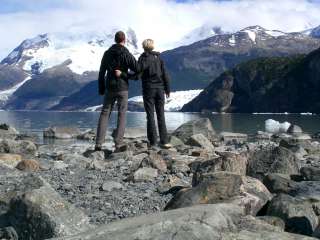
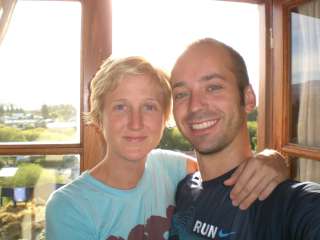
 But now we are here and the living is easy. We are rapidly learning/re-learning Spanish and consuming wine, both things that we’ve been anxiously looking forward to. Three evenings in a row, I’ve had steak for supper and I think that perhaps three might be the limit. Not so with wine, though. I can’t get enough of it or of the view we have from our room in the hostel, America Del Sur, a.k.a. the best hostel in the world. This town is perched on the edge of Lake Argentina which borders a few glaciers in the national park; I can’t see them from the window but the lake and the Andes make a glorious view at any time of day. We haven’t seen the southern cross constellation yet but I’m keeping my eyes peeled. Meanwhile, our jet lag is wearing off, our exercise is increasing, we’re breathing lots of fresh, cool air and are starting to feel invigorated with some the thought of some brilliant hiking in our near future.
But now we are here and the living is easy. We are rapidly learning/re-learning Spanish and consuming wine, both things that we’ve been anxiously looking forward to. Three evenings in a row, I’ve had steak for supper and I think that perhaps three might be the limit. Not so with wine, though. I can’t get enough of it or of the view we have from our room in the hostel, America Del Sur, a.k.a. the best hostel in the world. This town is perched on the edge of Lake Argentina which borders a few glaciers in the national park; I can’t see them from the window but the lake and the Andes make a glorious view at any time of day. We haven’t seen the southern cross constellation yet but I’m keeping my eyes peeled. Meanwhile, our jet lag is wearing off, our exercise is increasing, we’re breathing lots of fresh, cool air and are starting to feel invigorated with some the thought of some brilliant hiking in our near future.